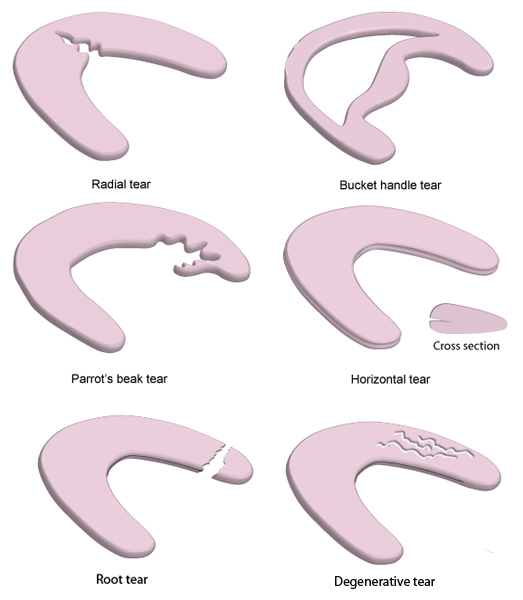Etiology
Traumatic meniscal tears most commonly occur during sports such as American football, rugby, soccer, and basketball, but skiers, runners, and tennis players are also at risk.[12] Older patients can tear their meniscus during normal activities of daily living, usually as a consequence of aging and degenerative wear of the knee joint (knee joint arthritis).
Meniscal tear is associated with cartilage defect, loss of cartilage volume, and alteration in bone size. Radiographic evidence of osteoarthritis can accompany meniscal damage, suggesting that meniscal tear in non-osteoarthritic people may be an early event in the disease process, and may be a risk factor for knee cartilage damage and articular structural changes.[8][10][13]
The degree of vascular penetration into the periphery of the meniscus ranges from 10% to 25% of the meniscal width. Consequently, most areas of the meniscus cannot heal by themselves because they are not vascularized.[14]
Additional risk factors include occupations that stress the joint (e.g., construction work and manual labor jobs that involve knee flexion while lifting heavy objects, as well as excessive kneeling or squatting), malalignment of the knee joint, previous ligament injury (especially anterior cruciate ligament injury), and knee instability.[12] Furthermore, it is suggested that increased friction from various sporting turfs may lead to a meniscal tear. Poor ground or weather conditions increase the likelihood of slips, falls, and improper landings, further increasing the risk of meniscal tears.[15] The presence of a discoid meniscus is also associated with a slightly higher risk of meniscal tears (discoid lateral meniscus is found in 3.5% to 5% of meniscal tear patients).[16]
Pathophysiology
The medial and lateral menisci are shock absorbers and force distributors located between the femur and the tibia. Consequently, menisci can tear due to traumatic injury or degenerative wear (e.g., in knee joint arthritis), and can compromise force distribution across the knee joint, increasing force concentration on the cartilage and other joint structures.[17]
Damage to the meniscus due to rotational forces directed to a flexed knee (as may occur with pivoting or twisting sports) is the usual underlying mechanism of injury. A valgus force applied to a flexed knee with the foot planted and the femur rotated externally can result in a lateral meniscus tear. A varus force applied to the flexed knee when the foot is planted and the femur rotated internally can result in a tear of the medial meniscus.
Tears produce rough surfaces inside the knee, which cause catching, locking, buckling, pain, or a combination of these symptoms. Results from one prospective study suggest that the severity of these symptoms may be related to the degree of underlying cartilage damage rather than the meniscal tear itself.[18]
Abnormal loading patterns and rough surfaces inside the knee, especially when coupled with return to sports, significantly increase the risk of developing arthritis if not already present.[19][Figure caption and citation for the preceding image starts]: Anatomical structures around the menisciCreated by BMJ Publishing Group [Citation ends].
Classification
Vertical tears
Generally caused by an acute trauma.[1]
Longitudinal tear
Tear along the longitudinal axis of the meniscus.
Radial tear
Tear transverse to the circumferential fibers of the meniscus.
Bucket handle tear
Complete longitudinal tear that results in a peripheral and inner fragment.
Horizontal tears
Generally degenerative in nature.[1]
Transverse tear
Tear in the horizontal axis of the meniscus.
Cleavage tear
Complete transverse tear that separates the meniscus into a superior and inferior fragment.
Parrot's beak tear
A combined, incomplete radial and longitudinal tear, with a displaceable component that resembles a parrot's beak.
Root tear
Tear in the anterior or posterior meniscal roots where the meniscus attaches to the central tibial plateau.
Degenerative tear
Can occur as a result of traumatic or degenerative arthritis.
More commonly seen in older people.[2]
[Figure caption and citation for the preceding image starts]: Types of meniscal tearsCreated by BMJ Publishing Group [Citation ends].
Stable tear[1]
Usually involves partial or very short tears in the meniscus.
Unstable tear[1]
Includes radial and bucket handle tears.
The central portion of the torn meniscus may dislocate toward the joint space to the center of the femoral condyle, causing locking and acute pain.
Consensus classification for meniscal findings on magnetic resonance imaging[3]
Treatable lesion: meniscal surgery may be indicated
Bucket handle tear
Displaced meniscal tear
Meniscal root failure
Indeterminate lesion: meniscal surgery may be indicated
Undisplaced meniscal tear
Radial tear
Radial flap tear
Complete radial split tear
Partial radial split tear
Horizontal tear with or without cyst
Horizontal cleavage tear and meniscal cyst
Horizontal cleavage tear in isolation
Complex meniscal lesion
Short longitudinal tear
Unlikely treatable: meniscal surgery not indicated
Contour abnormality
Isolated meniscal extrusion
No tear
Use of this content is subject to our disclaimer